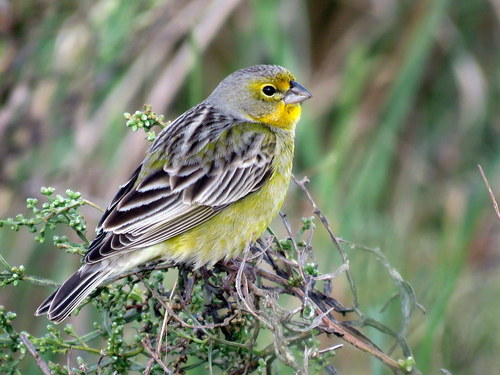
Grassland Yellow-finch
The Grassland Yellow-Finch (*Sicalis luteola*) is a small, vibrant bird belonging to the tanager family (Thraupidae). It is a common inhabitant of open grasslands and agricultural areas across much of South America. Known for its bright yellow plumage in males and its cheerful, lively song, the Grassland Yellow-Finch plays an important role in its ecosystem as a seed disperser and insect consumer. While not currently considered globally threatened, some populations face localized pressures from habitat loss. It is sometimes kept as a cage bird in some regions, though this practice is increasingly regulated.
11-13 cm
Length
18-21 cm
Wingspan
Least Concern
Conservation Status
Distribution
The Grassland Yellow-Finch is widespread throughout South America, occurring in Argentina, Bolivia, Brazil, Chile, Colombia, Ecuador, French Guiana, Guyana, Paraguay, Peru, Suriname, Uruguay, and Venezuela. Some populations exhibit seasonal movements, though it is not considered a long-distance migrant. It is found in lowlands from sea level up to around 3000 meters.
Lifespan
Typically 3-5 years in the wild, potentially longer in captivity. Precise lifespan data is limited.
Grassland Yellow-finch's Habitat
Habitat Types
Grasslands, Pastures, Agricultural fields, Savannas, Open woodlands
Climate Zones
Tropical, Subtropical, Temperate
Adaptations
Their relatively short, conical beaks are well-suited for cracking seeds, a staple of their diet. Their preference for open habitats allows for easy foraging and detection of predators.
Variations
Several subspecies are recognized, differing slightly in plumage coloration and size. For example, *S. l. luteola* is found in eastern South America, while *S. l. bogotensis* occurs in the northern Andes.
Appearance
Breeding Plumage
Breeding males are bright yellow overall, with olive-green wings and back. Non-breeding males and females are duller, with more olive-brown upperparts and yellowish underparts.
Seasonal Feather Changes
The intensity of the yellow coloration in males can vary seasonally, becoming brighter during the breeding season.
Sex Based Plumage Differences
Males are significantly brighter yellow than females, especially during the breeding season. Females are generally duller and more streaked.
Notable Features
Bright yellow plumage (in males), Conical bill, Relatively short tail
Diet and Feeding
Primary Foods
Seeds, Small insects, Arthropods
Foraging Behavior
Forages primarily on the ground, often in small flocks. They hop and peck at seeds and small invertebrates. They may also glean insects from low vegetation.
Specializations
Their conical bill is adapted for efficiently cracking open seeds of various sizes.
Seasonal Diet Variations
The proportion of seeds and insects in their diet may vary depending on availability. During the breeding season, insects may become a more important food source, especially for feeding young.
Behavior
Social Structure
Generally found in pairs or small flocks, especially outside of the breeding season. Larger flocks may form at abundant food sources.
Communication
A variety of chirps and whistles, A cheerful, warbling song used for territorial defense and mate attraction, Visual displays, such as wing fluttering
Migration
Most populations are resident or exhibit short-distance movements in response to food availability or rainfall. They are not considered long-distance migrants.
Territorial or Group Behaviors
During the breeding season, males defend territories against other males. Outside of breeding, they are generally more social and form flocks.
Conservation
Threats
Habitat loss due to agricultural expansion, Pesticide use, Trapping for the cage bird trade (in some regions)
Protection Programs
General habitat conservation efforts, Regulations on bird trapping in some countries
Local National Laws
Protected under various national wildlife laws in some countries within its range.
Population Trend
Stable
Population Estimates
While precise numbers are difficult to obtain, it is considered a common species throughout much of its range.
Interesting Facts
They are known for their adaptability to human-modified landscapes.
This has allowed them to thrive in agricultural areas and pastures, unlike some other grassland bird species.
The genus name *Sicalis* comes from the Greek word *sikalis*, referring to a small, black-headed bird.
Although the Grassland Yellow-Finch is not black-headed, the genus includes a variety of similar finch-like birds.
They often bathe in dust or water.
Like many birds, it uses dust or water bath to keep its feather clean.
Faqs about Grassland Yellow-finch
Are Grassland Yellow-Finches good pets?
While they are sometimes kept as cage birds, their welfare is best served in their natural habitat. Regulations on trapping and keeping them vary by country. Consult local wildlife laws.
What do I do if I find an injured Grassland Yellow-Finch?
Contact a local wildlife rehabilitator or veterinarian for advice. Do not attempt to care for the bird yourself without professional guidance.
How can I attract Grassland Yellow-Finches to my yard?
If you live within their range, providing a source of native grass seeds and avoiding pesticide use may attract them. Providing a source of water can also be beneficial.
Copyright @ Nature Style Limited. All Rights Reserved.
 English
English